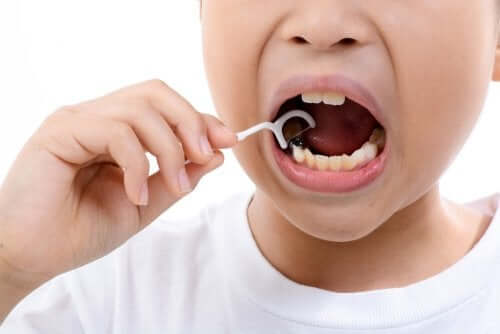Dental Fluorosis in Children: What You Should Know


Written and verified by the doctor María Belén Del Río
Dental fluorosis is a public health problem that affects children in many endemic areas in various regions of the world.
Experts discovered it in the 40s. They saw that water that was rich in fluoride produced abnormal tooth enamel coloration. After investigating this fact, they saw that the cause of these dental changes was excessive fluoride intake during tooth enamel formation, meaning in childhood.
“For many years, people considered dental fluorosis a cosmetic problem, not a health problem. But exposure to high fluoride levels has other bodily consequences, not only in the teeth.”
Manifestations of dental fluorosis
Dental fluorosis can manifest itself in different ways, depending on the severity or stage of the condition. In most cases, fluorosis is mild and manifests as thin white lines on the teeth.
In more severe cases, teeth become fragile, the enamel surface becomes irregular, and brown spots appear.
“Fluoride is an important mineral that protects teeth and helps prevent tooth decay. However, excessive amounts of flouride doesn’t allow tooth enamel to mature. It causes teeth hypomineralization, making them more porous. The most vulnerable stage is from birth to ages six to eight.”
Fluoride is mainly absorbed in the gastrointestinal tract. When we ingest fluoride orally, a portion remains in the oral fluids and may be incorporated into the teeth. However, most of it goes to the stomach and is absorbed in the intestines.

A study experts conducted in Ukraine investigated the health of children affected by dental fluorosis. They concluded that children who had this disease had a weaker and more precarious health compared to children who didn’t suffer from this condition.
In this regard, they presented more gastrointestinal and respiratory diseases, bone and muscle diseases, mental disorders, nervous system diseases, more incidence of tooth decay, and were smaller in size.
“Therefore, dental fluorosis isn’t a dental problem exclusively. Too much fluoride can also cause bone diseases. In addition, experts now know that it’s also a sign of thyroid gland disorders.”
Amount of fluoride needed
“The amount of fluoride humans need isn’t far from toxicity. On the one hand, it’s necessary to incorporate a sufficient dose to prevent tooth decay. On the other hand, too much fluoride can cause fluorosis.”
The use of fluoride is recommended within safety limits, according to the World Health Organization (WHO). They’re necessary public health measures for people who live in areas where fluoride is insufficient to incorporate adequate doses of this substance. Also, it’s necessary to remove excess fluoride in drinking water in high-risk areas.
In Europe, to avoid this condition, the amount of fluoride toothpaste can contain is regulated. And especially toothpaste for children. Toothpaste can’t contain more than 1500 ppm of fluoride. In addition, those that contain more than 1000 ppm of fluoride must include a warning on the label to be used exclusively by adults.
Treatment
Regarding treatment, you should know that dental fluorosis is irreversible. There’s no definitive solution to improve teeth condition. For aesthetic reasons, you can use some procedures to improve the appearance of your teeth. For example:
- You may whiten brown spots with specific agents such as hydrogen peroxide. Depending on the severity of your dental fluorosis, whitening may be more or less effective. You have to go to a dentist to get this whitening regularly.
- Also, you can resort to dental veneers. These modify the appearance of teeth with materials that perfectly mimic the shape and color of natural teeth.

Prevention of dental fluorosis
To prevent the onset of this condition, it’s important to keep in mind the fluoride content of the water that your child drinks, as well as the fluoride content in toothpaste, and whether or not your child receives fluoride supplements. This way, you can ensure adequate levels and avoid excessive intake.
You should always supervise your children while they brush their teeth. Parents should ensure that children don’t use too much toothpaste and learn to spit and not swallow it. The same goes for mouthwash. In addition, we recommended taking your child to the dentist regularly.
Dental fluorosis is a public health problem that affects children in many endemic areas in various regions of the world.
Experts discovered it in the 40s. They saw that water that was rich in fluoride produced abnormal tooth enamel coloration. After investigating this fact, they saw that the cause of these dental changes was excessive fluoride intake during tooth enamel formation, meaning in childhood.
“For many years, people considered dental fluorosis a cosmetic problem, not a health problem. But exposure to high fluoride levels has other bodily consequences, not only in the teeth.”
Manifestations of dental fluorosis
Dental fluorosis can manifest itself in different ways, depending on the severity or stage of the condition. In most cases, fluorosis is mild and manifests as thin white lines on the teeth.
In more severe cases, teeth become fragile, the enamel surface becomes irregular, and brown spots appear.
“Fluoride is an important mineral that protects teeth and helps prevent tooth decay. However, excessive amounts of flouride doesn’t allow tooth enamel to mature. It causes teeth hypomineralization, making them more porous. The most vulnerable stage is from birth to ages six to eight.”
Fluoride is mainly absorbed in the gastrointestinal tract. When we ingest fluoride orally, a portion remains in the oral fluids and may be incorporated into the teeth. However, most of it goes to the stomach and is absorbed in the intestines.

A study experts conducted in Ukraine investigated the health of children affected by dental fluorosis. They concluded that children who had this disease had a weaker and more precarious health compared to children who didn’t suffer from this condition.
In this regard, they presented more gastrointestinal and respiratory diseases, bone and muscle diseases, mental disorders, nervous system diseases, more incidence of tooth decay, and were smaller in size.
“Therefore, dental fluorosis isn’t a dental problem exclusively. Too much fluoride can also cause bone diseases. In addition, experts now know that it’s also a sign of thyroid gland disorders.”
Amount of fluoride needed
“The amount of fluoride humans need isn’t far from toxicity. On the one hand, it’s necessary to incorporate a sufficient dose to prevent tooth decay. On the other hand, too much fluoride can cause fluorosis.”
The use of fluoride is recommended within safety limits, according to the World Health Organization (WHO). They’re necessary public health measures for people who live in areas where fluoride is insufficient to incorporate adequate doses of this substance. Also, it’s necessary to remove excess fluoride in drinking water in high-risk areas.
In Europe, to avoid this condition, the amount of fluoride toothpaste can contain is regulated. And especially toothpaste for children. Toothpaste can’t contain more than 1500 ppm of fluoride. In addition, those that contain more than 1000 ppm of fluoride must include a warning on the label to be used exclusively by adults.
Treatment
Regarding treatment, you should know that dental fluorosis is irreversible. There’s no definitive solution to improve teeth condition. For aesthetic reasons, you can use some procedures to improve the appearance of your teeth. For example:
- You may whiten brown spots with specific agents such as hydrogen peroxide. Depending on the severity of your dental fluorosis, whitening may be more or less effective. You have to go to a dentist to get this whitening regularly.
- Also, you can resort to dental veneers. These modify the appearance of teeth with materials that perfectly mimic the shape and color of natural teeth.

Prevention of dental fluorosis
To prevent the onset of this condition, it’s important to keep in mind the fluoride content of the water that your child drinks, as well as the fluoride content in toothpaste, and whether or not your child receives fluoride supplements. This way, you can ensure adequate levels and avoid excessive intake.
You should always supervise your children while they brush their teeth. Parents should ensure that children don’t use too much toothpaste and learn to spit and not swallow it. The same goes for mouthwash. In addition, we recommended taking your child to the dentist regularly.
All cited sources were thoroughly reviewed by our team to ensure their quality, reliability, currency, and validity. The bibliography of this article was considered reliable and of academic or scientific accuracy.
- Hidalgo-Gato Fuentes, Iliana, Duque de Estrada Riverón, Johany, Mayor Hernández, Félix, & Zamora Díaz, Javier Domingo. (2007). Fluorosis dental: no solo un problema estético. Revista Cubana de Estomatología, 44(4).
- Gutiérrez, J. R., & Vega, L. H. (2005). Fluorosis dental: Metabolismo, distribución y absorción del fluoruro. Revista de la Asociación Dental Mexicana, 62(6), 225-229.
This text is provided for informational purposes only and does not replace consultation with a professional. If in doubt, consult your specialist.








